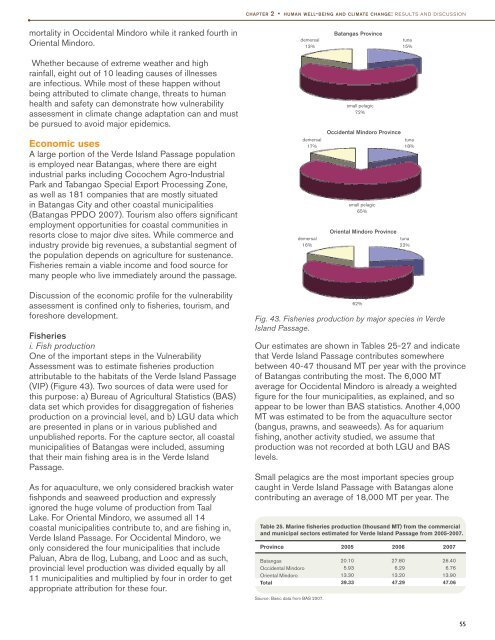of the Verde Island Passage, Philippines - weADAPT
of the Verde Island Passage, Philippines - weADAPT
of the Verde Island Passage, Philippines - weADAPT
You also want an ePaper? Increase the reach of your titles
YUMPU automatically turns print PDFs into web optimized ePapers that Google loves.
chapter 2 • human well-being and climate change: results and discussion<br />
mortality in Occidental Mindoro while it ranked fourth in<br />
Oriental Mindoro.<br />
demersal<br />
13%<br />
Batangas Province<br />
tuna<br />
15%<br />
Whe<strong>the</strong>r because <strong>of</strong> extreme wea<strong>the</strong>r and high<br />
rainfall, eight out <strong>of</strong> 10 leading causes <strong>of</strong> illnesses<br />
are infectious. While most <strong>of</strong> <strong>the</strong>se happen without<br />
being attributed to climate change, threats to human<br />
health and safety can demonstrate how vulnerability<br />
assessment in climate change adaptation can and must<br />
be pursued to avoid major epidemics.<br />
Economic uses<br />
A large portion <strong>of</strong> <strong>the</strong> <strong>Verde</strong> <strong>Island</strong> <strong>Passage</strong> population<br />
is employed near Batangas, where <strong>the</strong>re are eight<br />
industrial parks including Cocochem Agro-Industrial<br />
Park and Tabangao Special Export Processing Zone,<br />
as well as 181 companies that are mostly situated<br />
in Batangas City and o<strong>the</strong>r coastal municipalities<br />
(Batangas PPDO 2007). Tourism also <strong>of</strong>fers significant<br />
employment opportunities for coastal communities in<br />
resorts close to major dive sites. While commerce and<br />
industry provide big revenues, a substantial segment <strong>of</strong><br />
<strong>the</strong> population depends on agriculture for sustenance.<br />
Fisheries remain a viable income and food source for<br />
many people who live immediately around <strong>the</strong> passage.<br />
demersal<br />
17%<br />
demersal<br />
16%<br />
small pelagic<br />
72%<br />
Occidental Mindoro Province<br />
small pelagic<br />
65%<br />
Oriental Mindoro Province<br />
tuna<br />
18%<br />
tuna<br />
22%<br />
Discussion <strong>of</strong> <strong>the</strong> economic pr<strong>of</strong>ile for <strong>the</strong> vulnerability<br />
assessment is confined only to fisheries, tourism, and<br />
foreshore development.<br />
Fisheries<br />
i. Fish production<br />
One <strong>of</strong> <strong>the</strong> important steps in <strong>the</strong> Vulnerability<br />
Assessment was to estimate fisheries production<br />
attributable to <strong>the</strong> habitats <strong>of</strong> <strong>the</strong> <strong>Verde</strong> <strong>Island</strong> <strong>Passage</strong><br />
(VIP) (Figure 43). Two sources <strong>of</strong> data were used for<br />
this purpose: a) Bureau <strong>of</strong> Agricultural Statistics (BAS)<br />
data set which provides for disaggregation <strong>of</strong> fisheries<br />
production on a provincial level, and b) LGU data which<br />
are presented in plans or in various published and<br />
unpublished reports. For <strong>the</strong> capture sector, all coastal<br />
municipalities <strong>of</strong> Batangas were included, assuming<br />
that <strong>the</strong>ir main fishing area is in <strong>the</strong> <strong>Verde</strong> <strong>Island</strong><br />
<strong>Passage</strong>.<br />
As for aquaculture, we only considered brackish water<br />
fishponds and seaweed production and expressly<br />
ignored <strong>the</strong> huge volume <strong>of</strong> production from Taal<br />
Lake. For Oriental Mindoro, we assumed all 14<br />
coastal municipalities contribute to, and are fishing in,<br />
<strong>Verde</strong> <strong>Island</strong> <strong>Passage</strong>. For Occidental Mindoro, we<br />
only considered <strong>the</strong> four municipalities that include<br />
Paluan, Abra de Ilog, Lubang, and Looc and as such,<br />
provincial level production was divided equally by all<br />
11 municipalities and multiplied by four in order to get<br />
appropriate attribution for <strong>the</strong>se four.<br />
small pelagic<br />
62%<br />
Fig. 43. Fisheries production by major species in <strong>Verde</strong><br />
<strong>Island</strong> <strong>Passage</strong>.<br />
Our estimates are shown in Tables 25-27 and indicate<br />
that <strong>Verde</strong> <strong>Island</strong> <strong>Passage</strong> contributes somewhere<br />
between 40-47 thousand MT per year with <strong>the</strong> province<br />
<strong>of</strong> Batangas contributing <strong>the</strong> most. The 6,000 MT<br />
average for Occidental Mindoro is already a weighted<br />
figure for <strong>the</strong> four municipalities, as explained, and so<br />
appear to be lower than BAS statistics. Ano<strong>the</strong>r 4,000<br />
MT was estimated to be from <strong>the</strong> aquaculture sector<br />
(bangus, prawns, and seaweeds). As for aquarium<br />
fishing, ano<strong>the</strong>r activity studied, we assume that<br />
production was not recorded at both LGU and BAS<br />
levels.<br />
Small pelagics are <strong>the</strong> most important species group<br />
caught in <strong>Verde</strong> <strong>Island</strong> <strong>Passage</strong> with Batangas alone<br />
contributing an average <strong>of</strong> 18,000 MT per year. The<br />
Table 25. Marine fisheries production (thousand MT) from <strong>the</strong> commercial<br />
and municipal sectors estimated for <strong>Verde</strong> <strong>Island</strong> <strong>Passage</strong> from 2005-2007.<br />
Province 2005 2006 2007<br />
Batangas<br />
Occidental Mindoro<br />
Oriental Mindoro<br />
Total<br />
Source: Basic data from BAS 2007.<br />
20.10<br />
5.93<br />
13.30<br />
39.33<br />
27.80<br />
6.29<br />
13.20<br />
47.29<br />
26.40<br />
6.76<br />
13.90<br />
47.06<br />
55
















